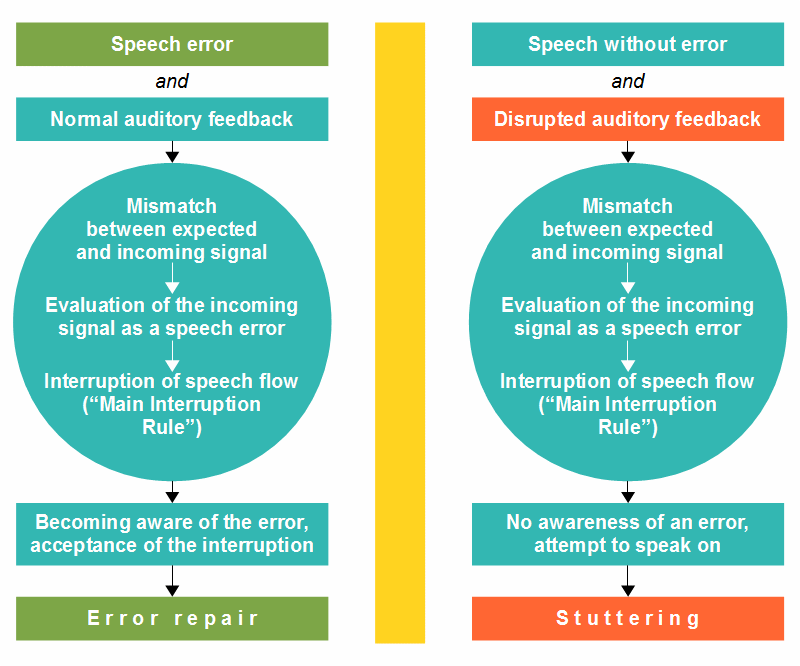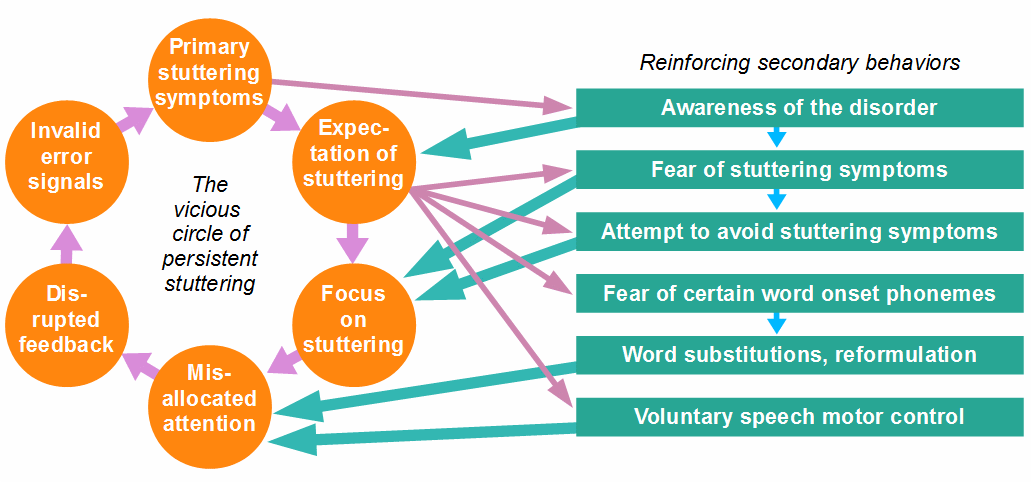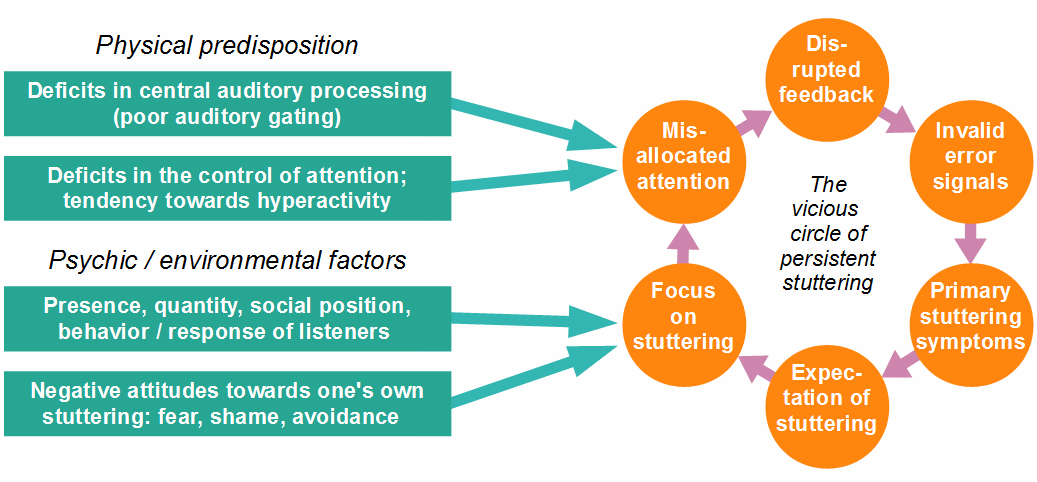 A Theory of Stuttering
A Theory of Stuttering
“We are born too soon to understand how the intermorphemic breaks in fluency we call stuttering are really produced, but it seems highly plausible that distortion in the total feedback signal system may be responsible for them.” (Van Riper, 1971, p. 395). To answer the question of how stuttering comes about is my aim on this website. I propose a theory of developmental stuttering, and the feedback signal system plays a crucial role in it.
Stuttering has been a subject of scientific research for a long time, and many theories of its nature and origin have been proposed. Today, thanks to new technical capabilities in brain research, we know much more about what is different in the brain of people who stutter, compared to normally fluent speakers. Additionally, some specific mutations were found in families in which stuttering has frequently occurred. But up to now, we don’t know how such neurological or genetic deviations make people, against their will, repeat words or parts of words, prolong sounds, or get totally stuck.
A plethora of empirical data about stuttering and about people who stutter was collected in the last decades without leading to a convincing, generally accepted theory. It is, however, impossible to logically derive theories from empirical data. Theories come about by thinking and modeling. Empirical data, on the one hand, can be suggestions that give thoughts a direction; on the other hand, they are bottom-up constraints confining the number of possible and plausible assumptions (read more).
The theory of stuttering presented on this website is a product of thinking and modeling, and any theory can be wrong. However, many features of the disorder are well known, and we can formulate questions about the causes of these features. A theory of stuttering has to answer these questions in a coherent and consistent manner. If a theory can do this, it should be considered a candidate for the correct theory.
December 19, 2025:
The fourth video about my theory is online.
August 20, 2025:
Important addition in Section 1.2: A new word-based model of the mental lexicon, assuming separate perceptual and motor word forms.
August 18, 2025:
The third video about my theory is online.
June 10, 2025:
The second video about my theory is online.
April 15, 2025:
The first video about my theory is online.
Dec. 1, 2024
External attention—what should it focus on? A comment on Bauerly and Jackson (2024)
July 7, 2024
Article: How fluency-enhancing conditions reduce stuttering. A unified explanation. (Journal of Medical Hypotheses).
Sept. 23, 2023
Article: Developmental stuttering may be caused by insufficient processing of auditory feedback (Journal of Medical Hypotheses, open access)
Currently updated
List of studies about auditory processing deficits in stutterers.
The role of auditory feedback (hearing one’s own voice) in stuttering has been controversially discussed for years. In many studies, alterations of auditory feedback were found to reduce stuttering; however, the mechanisms underlying those effects are hardly understood. On this website, I propose that persistent developmental stuttering is caused by insufficient processing of auditory feedback, which results in invalid error signals in the monitoring system; these error signals then interrupt the flow of speech. The processing deficit is ascribed to a misallocation of attention during speech. The theory accounts for the emergence of childhood stuttering, for the way stuttering becomes persistent, for the typical positions of stuttering events in sentences, and for the variability of the disorder depending on syntactic complexity, anticipation, and environmental factors.

The figure shows the core idea of the theory. The detection of a speech error (left) and stuttering (right) are based on the same mechanism; the internal monitoring system (in the circle) behaves equally in both cases. The disruption of auditory feedback (right) is thought to be caused by too little attention to the auditory channel during speech, that is, by too little perceptual or processing capacity for auditory feedback.
The main theses of the theory are:

The above figure shows the causal chain underlying stuttering (AF = auditory feedback). The causal chain closes to a vicious circle if the experience of stuttering results in the anticipation or fear of stuttering, such that the speaker’s attention is more and more focused on the disorder during speech (see the figures below).

The figures show the vicious circle of persistent stuttering. Above: with some secondary behaviors that reinforce the vicious circle. Below: with factors (perhaps genetically caused) that may contribute to a predisposition for stuttering, and factors that can increase the frequency and severity of the symptoms (the circle has been rotated here only for reasons of depiction). The crucial component of the vicious circle is the allocation of attention; it is the interface between the mechanism underlying stuttering, on the one hand, and situational and emotional factors influencing stuttering severity, on the other hand.

The proposed theory implies (at least) four predictions:

This diagram corresponds to Fig. 1 in Fiorin et al. (2021). It shows that amplified auditory feedback reduced the percentage of stuttering-like disfluencies (SLD) more than DAF and white noise did. Unlike DAF and noise, there can be no doubt that amplified auditory feedback attracts the speaker's attention
.
Here is the first one of a planned sequence of videos about the theory:
The second video is about attention and the processing of auditory speech feedback:
The third video is about the idea that invalid error signals in the monitoring system may trigger stuttering.
The fourth video is about the mechanism of stuttering, the way invalid error signals may trigger stuttering.